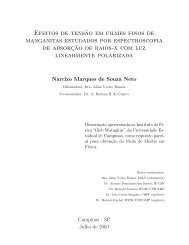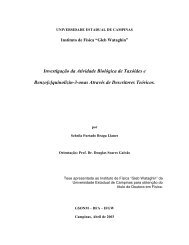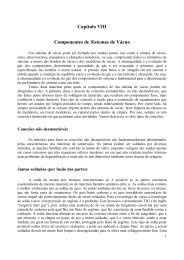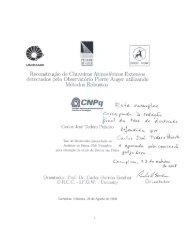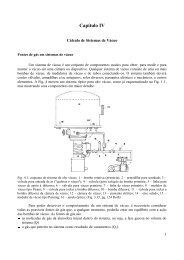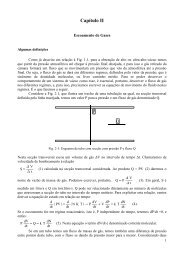- Page 1:
Universidade Estadual de Campinas I
- Page 4 and 5:
Agradecimentos Gostaria de agradece
- Page 6 and 7:
Abstract The optical tweezers is a
- Page 8 and 9:
2.5.3 CCD 63 2.5.4 Filtros Super NO
- Page 10 and 11:
5.4.8. Equação de Stokes ou “Cr
- Page 12 and 13:
morte celular. Passaram assim a uti
- Page 14 and 15:
feixe focalizado na borda nas posi
- Page 16 and 17:
óptica. Uma medida precisa da pot
- Page 18 and 19:
Os sistemas experimentais utilizado
- Page 20 and 21:
Para entender como um único feixe
- Page 22 and 23:
Figura 7. Forças de dois raios par
- Page 24 and 25:
Hemoglobina Absorção% (%) Melanin
- Page 26 and 27:
temperatura ambiente, a pinça ópt
- Page 28 and 29:
emissão laser em 1064 nm ocorre en
- Page 30 and 31:
não ionizando o gás da lâmpada.
- Page 32 and 33:
aumentando a reflexão no infraverm
- Page 34 and 35:
lentes Figura 18. Importância do t
- Page 36 and 37:
objetiva e não se tem a necessidad
- Page 38 and 39:
laminula distância de trabalho Fig
- Page 40 and 41:
em 3 dimensões. Entretanto, não s
- Page 42 and 43:
2.1.11 O Alinhamento O procedimento
- Page 44 and 45:
A lamínula fecha essa “micro‐p
- Page 46 and 47:
Feixe inclinado inclinação Abertu
- Page 48 and 49:
Substituindo agora d 12 , temos: d
- Page 50 and 51:
30, 50, 2.5, 5 cm. As distâncias d
- Page 52 and 53:
ligam fortemente pelas bordas. Esse
- Page 54 and 55:
Figura 42. Esfera integradora e alg
- Page 56 and 57:
apenas sinais com a mesma freqüên
- Page 58 and 59:
O principal componente de um laser
- Page 60 and 61:
potência (W) comprimento de onda (
- Page 62 and 63:
intensidade e a fase da componente
- Page 64 and 65:
Figura 51 b. Esse é um ponto crít
- Page 66 and 67:
2.5 Sistema Experimental de Pinça
- Page 68 and 69:
maior no centro, o que é equivalen
- Page 70 and 71:
perderiam esse sincronismo nas volt
- Page 72 and 73:
2.5.2 Monocromador Nos experimentos
- Page 74 and 75:
sinal Raman. A solução encontrada
- Page 76 and 77:
Tornamos o nosso micro‐Raman conf
- Page 79 and 80:
Capítulo 3 Teoria Óptica Eletroma
- Page 81 and 82:
que está embebido. Descobrimos, ap
- Page 83 and 84:
particularmente, nos artigos de Pau
- Page 85 and 86:
i t 1. Partindo de um campo elétri
- Page 87 and 88:
Com o intuito de facilitar os cálc
- Page 89 and 90:
obtendo o produto escalar de r c
- Page 91 and 92:
E b [ A ( , ) Z ( ka) e A ( , ) Z (
- Page 93 and 94:
m m 1 m 1jn( xg ) nTM M jn( Mx) dn
- Page 95 and 96:
e agora temos que se ∫ m ψ nm =
- Page 97 and 98:
tempo dentro de uma esfera devido
- Page 99 and 100:
Estendendo essa analogia entre a ó
- Page 101 and 102:
m′ m′ ∗ −k ∗ ∗ dPn′
- Page 103 and 104:
π 0 m n m n′ m n m n′ 2 dP dP
- Page 105 and 106:
∫ * * 1 * * { } 2 2 i Fi = Re
- Page 107 and 108:
n+ 1 n′ + 1 ( i) ( i) [ an n bn n
- Page 109 and 110:
+ {( ) 1 ρ [ ]} k cosϕ n i Hsϕ =
- Page 111 and 112:
2 E0 2 ∞ 2π F = ε ∑ Re {(2n+
- Page 113 and 114:
partículas capturadas pela pinça
- Page 115 and 116:
3.2.1 Aproximação da Integral Loc
- Page 117 and 118:
2 ∂ ρ 2 ∂ ρ ∇⋅ E=−∇
- Page 119 and 120:
Vamos procurar, portanto, soluçõe
- Page 121 and 122:
Ex = iωψ e , E y = 0 e E z = 0 (3
- Page 123 and 124:
Nesse ponto, economizamos páginas
- Page 125 and 126:
k ρ+ k ρ 2 2 2 2 0 − ∞ 2 2 m
- Page 127 and 128:
A expansão dos campos espalhados
- Page 129 and 130:
probabilidade de colisão. Além di
- Page 131 and 132:
Neste caso, tanto o campo elétrico
- Page 133 and 134:
para o caso de um feixe focalizado
- Page 135 and 136:
à polarização do laser, enquanto
- Page 137 and 138:
Intensidade (a.u.) perpendicular pa
- Page 139 and 140:
J1(kr)/kr, com um máximo central s
- Page 141 and 142:
Capítulo 4 Aplicações de Pinça
- Page 143 and 144:
espectroscopias que detectam os ní
- Page 145 and 146:
4.1.2 Objetivos e Desafios do Traba
- Page 147 and 148:
vistos como transições entre nív
- Page 149 and 150:
emite fótons no infravermelho. O q
- Page 151 and 152:
ásicos de óptica, monocromador e
- Page 153 and 154:
oxigênio, que ativa as plaquetas p
- Page 155 and 156:
Intensidade (a.u.) 450 500 550 600
- Page 157 and 158:
diferenciais ( 0) k a = 0 , i a t
- Page 159 and 160:
choque Processos multifótons são
- Page 161 and 162:
Dependendo do grau desses processos
- Page 163 and 164:
sinal coletado pela mesma objetiva
- Page 165 and 166:
4.7 Aplicações e Resultados de Lu
- Page 167 and 168:
varredura, entretanto, seria bem le
- Page 169 and 170:
demarcar os contornos. Por outro la
- Page 171 and 172: segundo harmônico é muito intensa
- Page 173 and 174: vantagens para reconstrução de im
- Page 175 and 176: Hiper Rayleigh, por também serem u
- Page 177 and 178: Capítulo 5 Óptica geométrica, Hi
- Page 179 and 180: fato é que, mantendo as mesmas con
- Page 181 and 182: Para realizar os somatórios, escre
- Page 183 and 184: partícula e v = 0 para o fluido n
- Page 185 and 186: A potência do laser foi medida com
- Page 187 and 188: importantes à medida que nossa cap
- Page 189 and 190: hospedeiro através da saliva. Os p
- Page 191 and 192: infecções em modelos in vitro e i
- Page 193 and 194: movimentar das duas formas. A leish
- Page 195 and 196: Tanto a forma bicôncava quanto a d
- Page 197 and 198: do fundo da câmara de Neubauer, cu
- Page 199 and 200: Nesse ponto vale a pena ressaltar u
- Page 201 and 202: que pode ser escrita como W WL µ L
- Page 203 and 204: Image Pro‐Plus. Mantivemos a hem
- Page 205 and 206: Usando o tempo de retorno medido e
- Page 207 and 208: parede porosa caem nessa categoria.
- Page 209 and 210: Nossos resultados mostraram que as
- Page 211 and 212: Para tanto coletamos 5 bolsas de do
- Page 213 and 214: viscosidade do plasma era 1.61 cP,
- Page 215 and 216: para esferas F = 6πµ av , onde a
- Page 217 and 218: 5.4.2 Equações de Continuidade Pa
- Page 219 and 220: π 22 π 11 π 22 π 12 π 21 π 21
- Page 221: 5.4.7. Equação de Navier‐Stokes
- Page 225 and 226: 128. Então, F(λ1) < F(C) < F(λ2)
- Page 227 and 228: de onde percebemos que a velocidade
- Page 229 and 230: Capítulo 6 Conclusão e Perspectiv
- Page 231 and 232: validade dos modelos empregados no
- Page 233 and 234: Apêndice 1 223
- Page 235 and 236: ∂m( δmk∂k)( e j∂j) −∂m(
- Page 237 and 238: ik iεω H = ∑ − AnmNnm − B
- Page 239 and 240: 7. Cálculo de Q pr Vamos agora cal
- Page 241 and 242: ⎧ τn n+ 1 iρ n+ 1 −iρ n iρ
- Page 243 and 244: 2π 2π 2 2 F → e = senθcos ϕ e
- Page 245 and 246: ( 2n + 1) ∞ ∞ 4π 2 * 2 π 2 nn
- Page 247 and 248: ( µω) n′+ 1 n+ 1 iρ { ( ) ( )
- Page 249 and 250: e agora por último, 2 E0 2 ∞ 4π
- Page 251 and 252: Apêndice 2 241
- Page 253 and 254: iii = 1 ; soma = 0 ; , True , iii +
- Page 255 and 256: H∗ programa para o feixe gaussian
- Page 257 and 258: T@n_, m_, p_D@ϕo_, λ_D := Hbn@n,
- Page 259 and 260: an@n_D := Han@nD = Hmn f2@n, xaD f1
- Page 261 and 262: 251
- Page 263 and 264: Referências 1 Ashkin, J. Dziedzic,
- Page 265 and 266: 20 Tese de Doutorado de Gaston Este
- Page 267 and 268: 43 J. X. Cheng, A. Volkmer, X. S. X
- Page 269 and 270: 63 H. Felgner, O. Müller, M. Schli
- Page 271: properties of stored red blood cell



